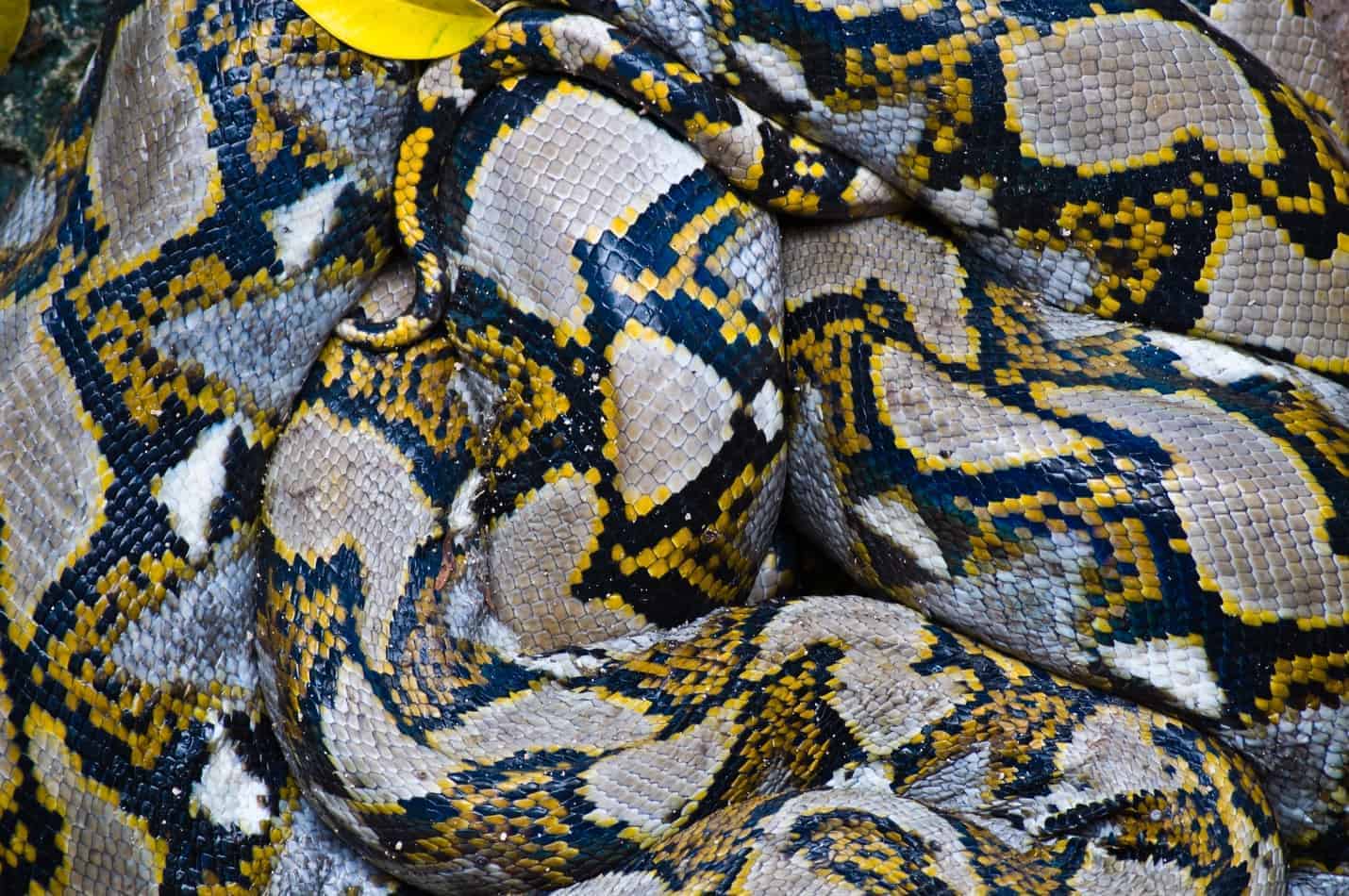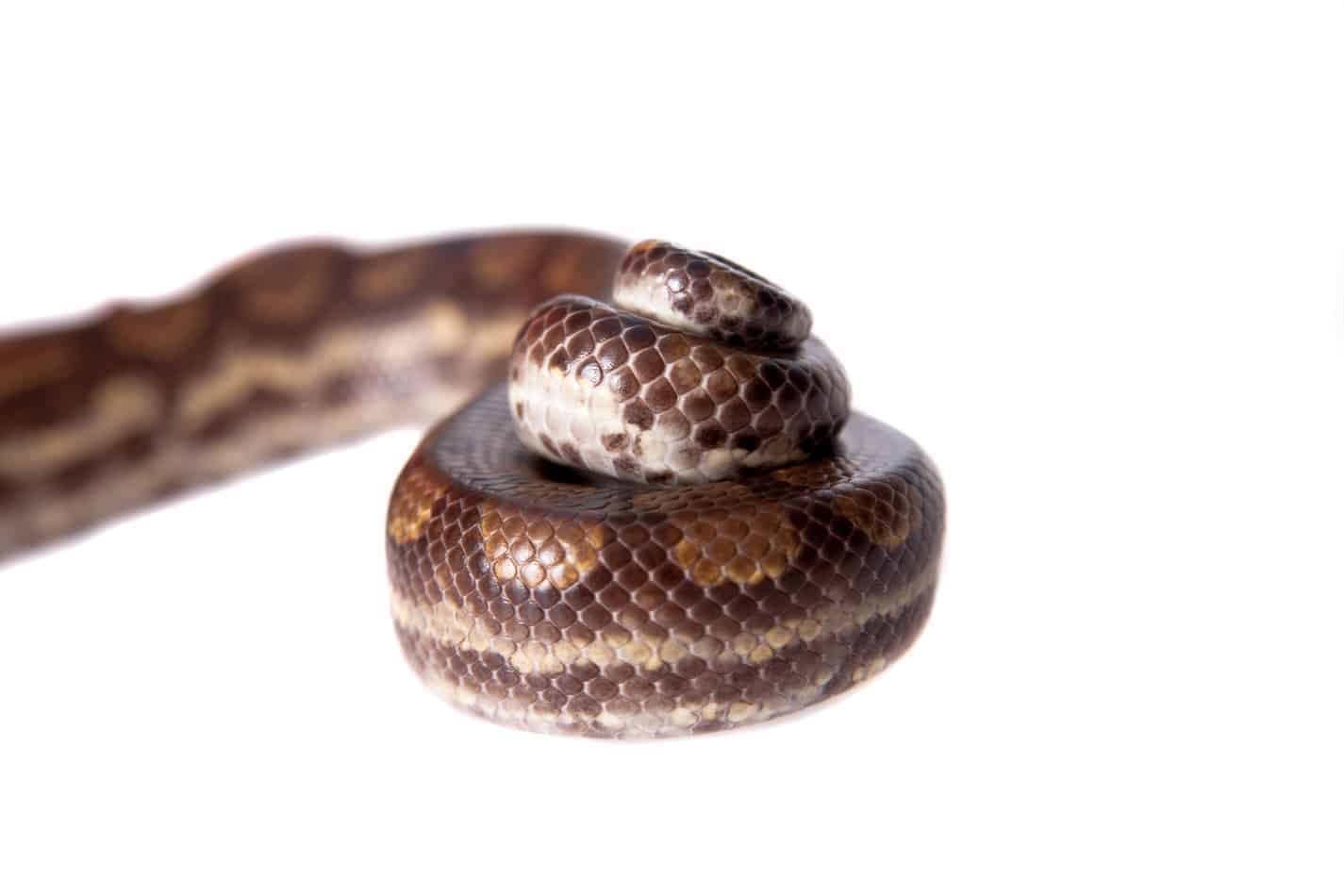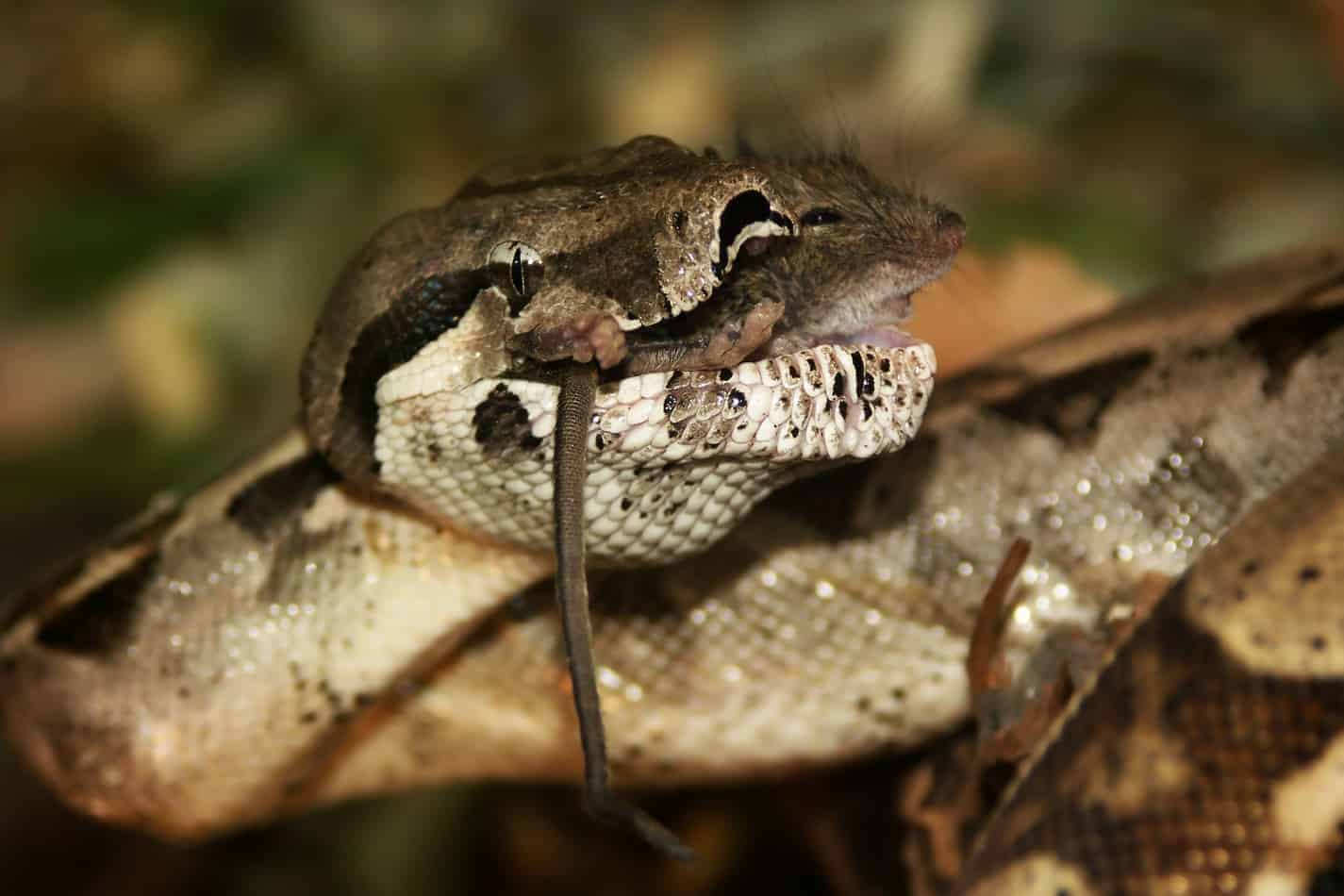27 Interesting Facts About Boa Constrictors (With Pictures)
I was talking to my brother who had gotten a pet Boa Constrictor, and he kept pointing out what amazing creatures they were. As our conversation continued I realized there must be something that I am missing about this snake – why did he think it was so great? As my research began I found that they are amazing, and to give you a quick dive into the majesty of the boa constrictor, here are 27 interesting facts.
1- Boa Constrictors do not Kill Through Suffocation
It is a myth that a boa constrictor wraps itself around its prey in an attempt to suffocate them. This myth makes sense, after all, that seems to be what’s going on, but after watching the boa constrictor in action it was found that their prey was dying too quickly. So a group of biologist set out to test this.
They rigged some anesthetized rats with pressure measuring devices and then dropped them into the cage with the boa constrictors. With each one, it was found that the point of constriction wasn’t emphasized around the lungs but rather around the blood vessels leading to the brain.
Their use of constriction is not to suffocate their prey but rather they squeeze so tight that it shut off its prey’s circulatory system prevent blood from getting to their preys brain. The result is death by ischemia.
2- Boa Constrictors do not Use Their Teeth to Chew

Boa constrictors have some sharp teeth but they aren’t used in the same way we use our teeth. In a boa constrictor, they are used to latch onto their prey and hold tight while they wrap the rest of their body around their prey. While these teeth do draw blood they aren’t very dangerous and are not the boa constrictors main utility for killing that would be constriction.
However, these teeth are absolutely instrumental to the process as boa constrictor are not the fastest snakes so it takes some time to wrap themselves properly around their prey. The teeth are a way for the boa constrictor to buy the rest of its body some time to catch up with its head.
3- Boa Constrictors Slowly Eat Larger Creatures as They Grow
Boa constrictors start small and grow to some very impressive lengths but with that growth requires a change in the food that they eat. While young and small they will eat rodent and small birds.
As they grow larger so does the prey that they eat, increasing to the point where boa constrictors will eat monkeys, wild boar, and deer. The size of the animal will determine how long before the boa constrictor will have to eat again.
With the boa constrictors larger size, they rarely have a hard time killing their prey either they just bite on, wrap themselves around their prey, and begin to squeeze until they cut off the creatures circulation and then they have a meal their next meal.
4- Boa Constrictors Digest Their Prey Through Some Very Strong Stomach Acid
Boa constrictors do not chew their food so the result is a lot of work for the snake’s stomach. Boa constrictors have strong stomach acid that works to break down their prey and transfer the nutrients throughout their long bodies.
The size of their previous meal will determine several things like digestion time and when they will need to eat again. With most sized meals, it will take anywhere from 6 to 10 days to digest and can lead to 3 to 5 weeks of the snake not needing another meal.
During the digestion period, the boa constrictor is rather dormant as it has no need for food and a lot of its body’s resources are being sourced to the digestive process of the body.
5- Boa Constrictors are Ambush Predators
Boa constrictors do not hunt their prey. Rather, they set a trap and will spring upon their prey when the moment arises. There are several myths that boa constrictors, as well as other snakes, can hypnotize their prey. This isn’t true; some scientists place this in a fear tactic category.
The fear makes the snake’s prey freeze up and then the snake attacks. In reality, a boa constrictor isn’t going to take the chance of letting its prey get away by waiting for them to freeze up in fear instead they will strike first launching their heads at their prey to latch on.
One of the reasons for this myth may be Disney’s The Jungle Book, however, the snake of Kaa is an unknown species of snake that in the original story lived well over 100 years. Given that there are no snakes that can live that long it seems safe to assume that most of Kaa’s attributes are fictional. This includes the ability to hypnotize prey.
6- Boa Constrictor Can Live Over 20 Years
Boa constrictors are one of the few snakes that can live over 20 years. In the wilderness, they have been found to live to about 30 and in captivity, they have been found to live up to 40 years.
Because of this, boa constrictors that are kept as pets are not suggested to be a pet that one keeps lightly as it is a long commitment to
The havoc that the snake would wreak upon the environment could change the whole local habitat into something else as boa constrictors have a very diverse diet they can choose from.
In their home environments, they are seen as the top of the food chain as not many fight them and they can pick almost any creature to eat.
7- Boa Constrictors Grow to Over 15 Feet Long

Boa constrictors are about two feet at birth. They continue to grow as they age, shedding more frequently when they are young because they need to grow skin to match their frequently changing size.
As the Boa constrictor continues to grow and reaches sexual maturity at about 2 to 3 years of age the boa constrictors shedding becomes more consistent. These snakes can then grow up to about 13 feet long though the longest reported Boa constrictor was 18 feet long.
With that length comes weight though. Boa constrictors that reach of 10 feet in size are likely to way 100 pounds or more. This weight can increase dramatically depending on how well digested their last meal is.
8- Female Boa Constrictors are Longer Than Male Boa Constrictors
Female Boa constrictors have to carry around their young so as a result, they are often long to compensate for their need to do this. As such females vary greatly in length from males being anywhere between 1 foot to 3 feet longer than some males of the same age.
It might be weird to think about because it’s not this way in humans, but the size difference weighs in the female’s direction. Furthermore with more length comes more weight. So as a boa constrictor you definitely don’t want to ask about a lady’s weight.
9- Several Male Boa Constrictor Will Compete for a Single Female
Female snakes attract mates to them through the releasing of a chemical trail. The result is usually several males stumbling onto the trail. When this happens the males will wrestle each other to determine who will get to mate with the female.
The winner of the wrestle gets the honor and will move on to meet up with female. Boa constrictors do not mate for life though so after they have mated they will move on to other females if they can find them. As such the weaker boa constrictors may not get to mate.
10- Female Boa Constrictors Can Have Virgin Births
Parthenogenesis better known as virgin birth is the act of a creature reproducing asexually or without a mate. In 2010, there was a Boa Constrictor that they found capable of doing this. These are exceptionally rare instances.
There are other snakes that can do so slightly more frequently, though certain snakes, like ball pythons, can reproduce using the old sperm of snakes they had mated with previously.
Thus it isn’t a virgin birth but rather a delayed pregnancy. Boa constrictors do not seem to be able to delay pregnancy and as such, they do have the capability of parthenogenesis or having a virgin birth.
11- Female Boa Constrictor Give Live Birth
Some snakes lay eggs, but boa constrictors do not. Instead of laying eggs the mother boa constrictor will keep the eggs inside her body. As a result, the eggs only come out when they hatch.
This is one of the reasons that female boa constrictors tend to be longer than males. As soon as their clutch is laid, the baby boa constrictors are immediately independent and their mother will not look after them.
12- Female Boa Constrictor Can Give Birth to up to 60 Babies
Most clutches include 20 to 50 babies but that is certainly not the limit. The record number of recorded birth from a boa constrictor is 77 babies. That’s insane.
Most snakes can barely get above 10 but boa constrictors can pump out almost 8 times that in a single clutch. Generally each year half of the female boa constrictors are pregnant so the boa constrictor community is quite lively.
Though boa constrictors are easy to hunt when they are
13- Boa Constrictor Are Slow Creatures
Their large size does come with some drawbacks as boa constrictor are incredibly slow creatures. They are generally earth traveling creatures and over and they can travel about 1 mile an hour.
That’s not fast but given how much length and weight they are pulling behind them it makes sense. Boa constrictors are excellent climbers and swimmers though they perform overland travel. Climbing trees and swimming does help them catch prey.
14- Boa Constrictors Move in a Stright Line
Several snakes move in a curved serpentine pattern where their body forms a sort of sine wave as they move allowing for the snake to bunch up its body and make itself a little springier.
Boa constrictors do not do this they push themselves forward in a single line pulling all of their weight behind them – all 13 or so feet of it. Can you imagine the traffic that causes? You thought waiting for the train was bad this snake is 13 feet long and only move one mile an hour, have fun
15- Boa Constrictors Use What is Left of Their Primeval Legs
Due to evolution creatures are left with vestigial organs or organs that are not used by the creature in their current form anymore. Several of these examples in humans include the grasping reflex, tailbone, and wisdom teeth.
Snakes ancestors used to have legs but they evolved past that as they focused more on burrowing as a species. Since legs got in the way of that, they were slowly cut out of the evolution. However, boa constrictors still have vestigial organs that mark where those legs used to be.
They are called anal spurs and they appear as little claws on the body of the snake. The claws may be capable of holding prey down depending on how well developed these vestigial organs are.
16- Boa Constrictors Patterns Are Beautiful

These patterns are hard to describe so I will let the pictures speak more than I can for the beauty of these patterns, but generally, boa constrictor are sought after for their patterns. That is one of the reasons they are kept as pets to show off their amazing colors.
From tan, yellow, red, pink or green the color of these snakes are diverse and often mesmerizing. Their patterns are made up of lines, circles, and diamond-like or oval shapes. Color and body prints depend on the habitat as these colors are used to blend in with their environment for camouflage.
17- Jaguars And Crocodiles Hunt Boa Constrictors
While boa constrictors are at the top of the food chain they do still have some predators. These predators have to be huge to even attempt taking on a boa constrictor but still they will hunt these snakes down.
Now you might be wondering why boa constrictors are still at the top of the food chain then. Well, that’s because while boa constrictors are hunted they will still eat what they are hunted by. Yeah, that’s right. Watch out crocodile. If you’re not careful the boa constrictor will kill you and eat you.
18- When in Combat the Boa Constrictor Will Ball Up Its Tail

While at the top of the food chain boa constrictors have to keep themselves safe using many forms of defense. One such form of defense is balling their tail up in an attempt to make their tail look like another head.
This technique is used to distract their opponents and then bite down with their real head at a vulnerable spot. With their several feet of length the snake’s tail barely looks like its a part of them anymore so it can confuse another snake quite a bit.
19- Boa Constrictors Can Hiss to be Heard 100 Feet Away
This is a defensive tool purely based in intimidation. In order to get to the boa constrictor, you have to move past your fear of its hiss. Even worse is that while that hiss is large it denotes a creature of large size, well that is a boa constrictor. You don’t exactly get much larger than a 13-foot snake.
20- Boa Constrictors were Hunted for Their Skin
If the pictures weren’t enough to persuade you then perhaps history is. Boa constrictors used to be hunted for their skin. Several people in South and Central America would sell these as commodities because of the incredible colors.
Boas were hunted so often that the creatures were thought to have reached endangered status. They haven’t yet, but the hunting of them has significantly lessened after taking note of the heavy decrease in boa constrictor population.
21- Pick Up Chemical Trails With Their Mouths
One trait of snakes in general that a boa constrictor shares is its ability to pick up chemical trails with their mouth. This is most similar to smelling and several people have associated the two as the same thing, however, it is a myth that a snake smells with its tongue.
First, a boa can smell with its nostrils and nose it doesn’t need its tongue. However, the boa constrictor will use its forked tongue to wave chemical trails into its mouth and then use receptors in the mouth to sense predators and prey.
22- Boa Constrictors Have Scales Around Their Mouths That Can Sense Heat
Yeah, that’s right, as if the super sniffer wasn’t enough for these snakes, they also have a sixth sense that allows them to sense heat. Sort of like infrared vision but not vision based.
These snakes are able to tell where sources of heat are using this sense. It’s pretty incredible over all to see these snakes at work. They use this sense to feel where it is best to bite into their prey. Pretty scare to think about.
23- Female Boa Constrictors Determine the Gender of Their Babies
Unlike humans
24- Boas Are Used For Pest Control
In several farms and ranches in Central and South America, boa constrictors are kept on the farm as animals used to hunt and kill their preferred prey of rodents. In particular mice can over run a farm, so boa constrictors help with that problem.
25- Boa Constrictors Prefer Solitude
Like many other snakes, companionship does very little for boa constrictors. They mate and move on. They prefer living by themselves and don’t really receive
26- Boa Constrictors Are Born With an Instinct to Hunt

Boa constrictors are born independent and part of that independent nature appears in the way that they hunt. Boa constrictors have diverse diets but are only carnivores, so from birth, they must hunt and they appear to be born with an awareness of how to use their bodies to their advantage.
They lay traps and perform defense mechanisms as soon as they are born. They do not need to be taught anything.
27- The Boa Constrictor is Considered One of Two of The Most Primitive Snakes
The boa constrictor and the python are considered the most primitive snakes. As such they are considered a high priority to keep alive in regard to the evolutionary discoveries that they can provide. Their ancient nature is also why they have such pronounced vestigial organs.
Related Questions
Has a boa constrictor ever killed someone? Only the longest pythons are considered serious threats to humans. As such Boa constrictors do not quite match the list. That being said, after one attack on its owner in Ohio, it has been shown that boa constrictors seem capable of killing a human.
Are boa constrictors good pets? Yes, boa constrictors are good pets, but they aren’t they highest listed as they are potentially dangerous and live for a very long time, so be aware of the choice you are making when having a boa constrictor as a pet it could be a 40-year decision. Furthermore, when feed a larger boa constrictor have a second person nearby in case there is some problem.
Are boa constrictors nocturnal? Yes, boa constrictors are nocturnal. They sleep during the day and lay traps at night. So they get most of their food early in the morning when their prey is groggily moving through their morning. It is the early morning boa constrictor that gets the mouse, I suppose.
